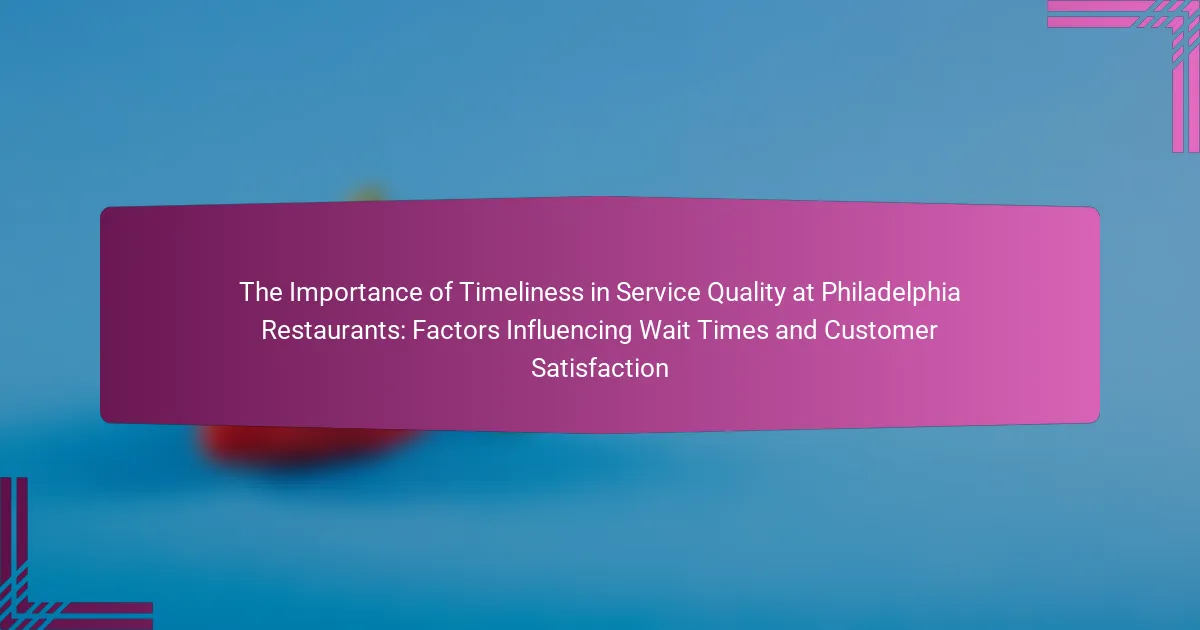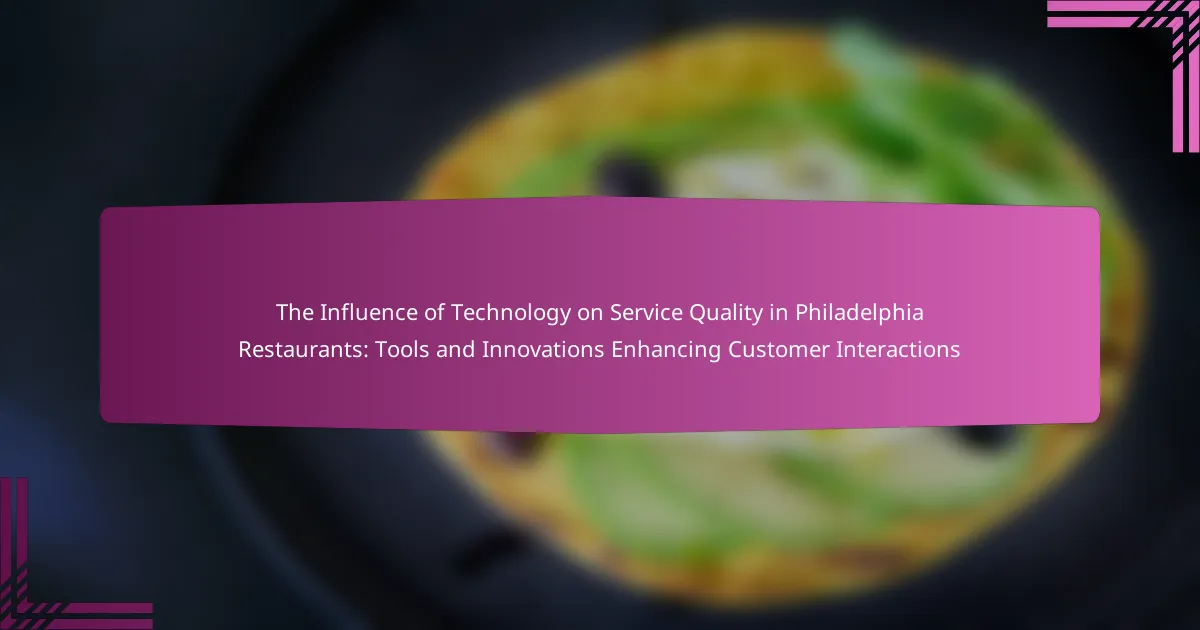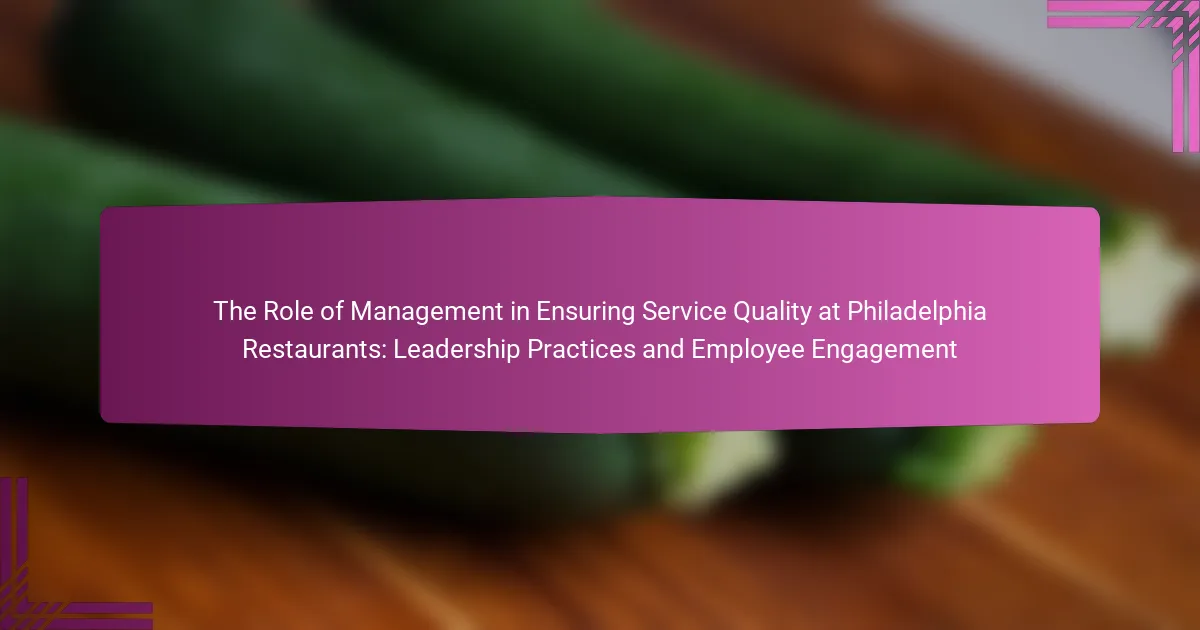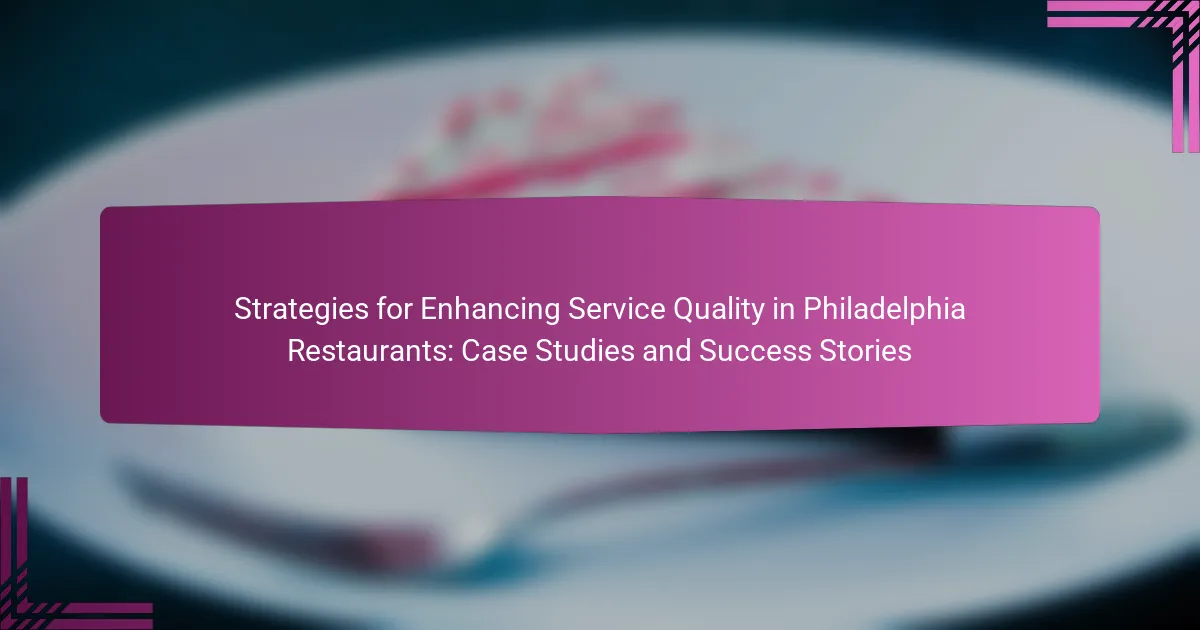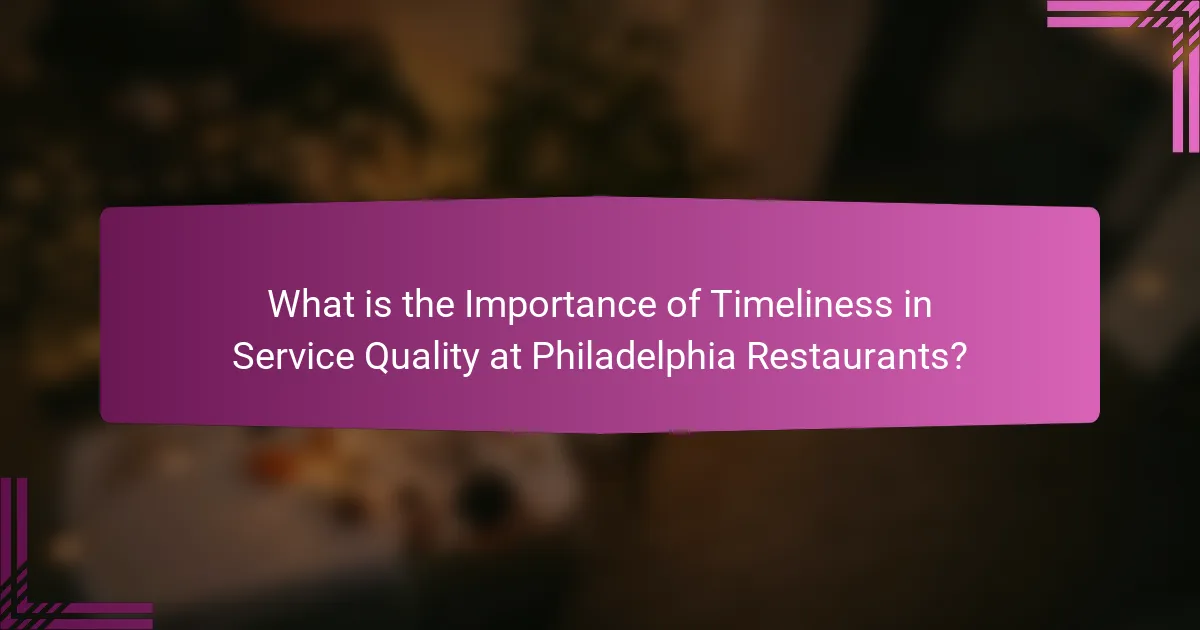
What is the Importance of Timeliness in Service Quality at Philadelphia Restaurants?
Timeliness is crucial in service quality at Philadelphia restaurants. It directly impacts customer satisfaction and repeat business. Quick service enhances the dining experience. Customers often associate promptness with professionalism. Research indicates that 70% of diners prioritize speed of service. Delays can lead to frustration and negative reviews. In a competitive market, timely service can differentiate a restaurant. Overall, timeliness fosters loyalty and encourages positive word-of-mouth.
How does timeliness impact customer satisfaction in restaurants?
Timeliness significantly impacts customer satisfaction in restaurants. Customers expect prompt service, and delays can lead to frustration. Research shows that longer wait times correlate with lower satisfaction ratings. A study by the Cornell University School of Hotel Administration found that timely service enhances the dining experience. Specifically, 70% of diners reported that wait time influenced their likelihood to return. Additionally, timely food delivery increases perceived value and overall satisfaction. In contrast, excessive wait times can result in negative reviews and loss of repeat business. Thus, managing timeliness is crucial for maintaining high customer satisfaction.
What are the key elements of service quality that relate to timeliness?
Key elements of service quality that relate to timeliness include responsiveness, reliability, and efficiency. Responsiveness refers to the ability of staff to address customer needs promptly. According to a study by Zeithaml, Parasuraman, and Berry, responsiveness is crucial for customer satisfaction. Reliability involves delivering services as promised within the expected time frame. A consistent delivery of timely service builds trust with customers. Efficiency focuses on minimizing wait times and optimizing service processes. Research indicates that reduced wait times lead to higher customer satisfaction rates in restaurants. Together, these elements significantly impact the overall perception of service quality in the restaurant industry.
How does wait time influence the overall dining experience?
Wait time significantly affects the overall dining experience. Longer wait times can lead to customer frustration and dissatisfaction. Research indicates that customers often associate wait times with service quality. A study published in the Journal of Service Research found that perceived wait time influences customer expectations. When customers feel they wait too long, their overall satisfaction decreases. Conversely, shorter wait times generally enhance customer satisfaction and encourage repeat visits. Efficient service can improve the perception of the dining experience. Thus, managing wait times is crucial for restaurants aiming to boost customer satisfaction.
Why is timeliness considered a critical factor in the restaurant industry?
Timeliness is critical in the restaurant industry because it directly impacts customer satisfaction. Customers expect their orders to be served promptly. Delays can lead to dissatisfaction and negative reviews. According to a study by the National Restaurant Association, 70% of customers rate speed of service as a key factor in their dining experience. Additionally, timely service can enhance operational efficiency. It allows restaurants to serve more customers in less time. This increases revenue potential and customer turnover. Overall, timeliness is essential for maintaining a positive dining experience and business success.
What role does timeliness play in repeat business for Philadelphia restaurants?
Timeliness is crucial for repeat business at Philadelphia restaurants. Customers expect prompt service during their dining experience. Delays can lead to dissatisfaction and negative reviews. Research indicates that 70% of diners prioritize speed of service when choosing where to eat. Timely service enhances customer satisfaction and encourages repeat visits. Restaurants that consistently deliver meals quickly build a loyal customer base. In Philadelphia’s competitive dining scene, efficiency can differentiate successful establishments from those that struggle.
How do customer expectations around wait times vary by restaurant type?
Customer expectations around wait times vary significantly by restaurant type. Fast-casual restaurants typically have lower tolerance for long waits. Customers expect quick service, often under 10 minutes. In contrast, fine dining establishments allow for longer wait times, often 20-30 minutes. This is due to the expectation of a more curated dining experience. Casual dining restaurants fall in between, with wait expectations of around 15-20 minutes. Research shows that these expectations correlate with the perceived quality of service. A survey by the National Restaurant Association indicates that 70% of customers prioritize speed in fast-casual settings. In fine dining, 60% of diners are willing to wait longer for higher quality meals. Thus, restaurant type directly influences customer wait time expectations.

What factors influence wait times in Philadelphia restaurants?
Wait times in Philadelphia restaurants are influenced by several factors. These factors include the restaurant’s location, time of day, and day of the week. High foot traffic areas tend to have longer wait times due to increased customer volume. Peak dining hours, such as weekends and evenings, also contribute to longer waits. Staffing levels play a crucial role; insufficient staff can lead to delays in service. Additionally, the complexity of the menu affects preparation times. Popularity and reputation of the restaurant can result in higher demand, impacting wait times. Seasonal events and holidays can further exacerbate these delays, as more patrons dine out.
How do staffing levels affect service speed and wait times?
Staffing levels directly impact service speed and wait times in restaurants. Higher staffing levels typically lead to faster service. This is because more staff can attend to customers simultaneously. When fewer staff members are present, the workload increases for each employee. This can result in longer wait times for customers. Research shows that restaurants with optimal staffing can reduce wait times by up to 30%. Conversely, understaffing can lead to customer dissatisfaction and decreased service quality. Studies indicate that a well-staffed environment enhances overall customer experience and satisfaction.
What are the common staffing challenges faced by Philadelphia restaurants?
Philadelphia restaurants commonly face staffing challenges such as high turnover rates, difficulty in finding qualified staff, and scheduling issues. High turnover rates in the restaurant industry can reach 70% annually, impacting service consistency. Many establishments struggle to attract skilled workers due to competitive job markets and wage disparities. Additionally, unpredictable scheduling demands make it hard to maintain adequate staffing levels during peak hours. These challenges can lead to longer wait times and affect overall customer satisfaction in Philadelphia’s dining scene.
How can effective staff training reduce wait times?
Effective staff training can significantly reduce wait times in restaurants. Training equips staff with the skills needed for efficient service. Well-trained employees can handle customer requests promptly. They learn to prioritize tasks effectively, minimizing delays. Training also improves teamwork among staff members. Cohesive teams can manage busy periods more smoothly. Research indicates that trained staff can reduce wait times by up to 30%. This efficiency enhances overall customer satisfaction.
What operational practices contribute to efficient service delivery?
Efficient service delivery is achieved through several operational practices. These include streamlined communication, effective staff training, and robust inventory management. Streamlined communication ensures that all team members are informed and coordinated. Effective staff training enhances employee skills, leading to quicker service. Robust inventory management prevents shortages and delays in service. Additionally, implementing technology, such as point-of-sale systems, can expedite transactions. Regular performance reviews help identify areas for improvement. Collectively, these practices contribute to reduced wait times and improved customer satisfaction in restaurants.
How does kitchen efficiency impact customer wait times?
Kitchen efficiency directly reduces customer wait times. Efficient kitchens streamline food preparation and service processes. This leads to quicker order fulfillment. Studies show that restaurants with high kitchen efficiency can serve customers 20-30% faster. Improved layout and optimized workflows contribute to this efficiency. When kitchen staff work effectively, food is prepared and delivered promptly. This results in higher customer satisfaction. Efficient kitchens also minimize errors, reducing the need for re-preparation. Overall, enhanced kitchen efficiency positively impacts customer wait times and experience.
What role does technology play in managing wait times?
Technology plays a crucial role in managing wait times at restaurants. It streamlines the reservation process through online booking systems. These systems allow customers to secure their tables in advance, reducing congestion. Digital waitlist management tools enable staff to monitor and communicate wait times effectively. Mobile applications provide real-time updates to customers, improving their experience. Additionally, data analytics can predict peak times and help optimize staffing levels. A study by the National Restaurant Association found that 70% of diners prefer restaurants that offer digital waitlist options. This indicates that technology not only enhances efficiency but also boosts customer satisfaction.
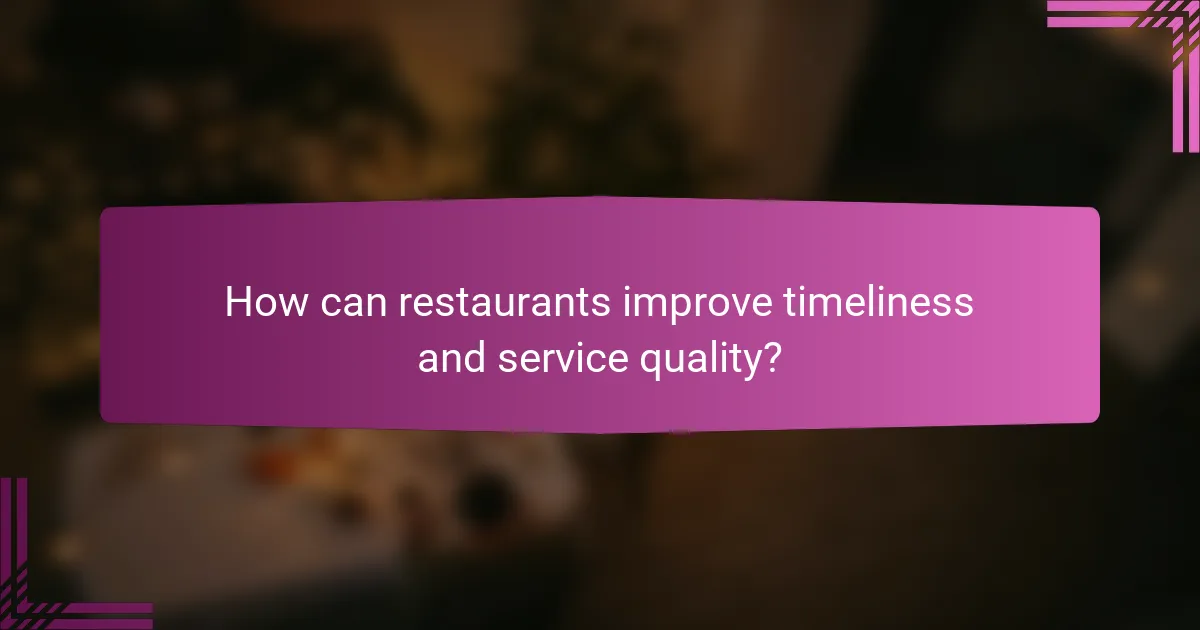
How can restaurants improve timeliness and service quality?
Restaurants can improve timeliness and service quality by optimizing staff training and workflow. Efficient training programs enhance staff skills in customer interaction and order management. Streamlined workflows reduce delays in food preparation and service. Implementing technology, like table management systems, helps coordinate service more effectively. Real-time communication between kitchen and front-of-house staff minimizes wait times. Regularly analyzing service performance data identifies bottlenecks in operations. Establishing clear service standards sets expectations for staff and customers. These strategies lead to increased customer satisfaction and repeat business.
What best practices can restaurants implement to enhance timeliness?
Restaurants can enhance timeliness by implementing efficient workflow management. Streamlining kitchen operations reduces order preparation time. Training staff on effective communication improves coordination between front and back of house. Utilizing technology, such as reservation systems, optimizes table management. Regularly monitoring and analyzing wait times helps identify bottlenecks. Offering pre-set menus during peak hours can speed up service. Implementing a feedback loop allows for continuous improvement in service delivery. These practices can significantly decrease wait times and boost customer satisfaction.
How can restaurants effectively manage reservations and walk-ins?
Restaurants can effectively manage reservations and walk-ins by implementing a structured system. This system should integrate technology for real-time updates on table availability. Utilizing reservation management software can streamline the booking process. Such software allows for easy adjustments based on walk-in traffic.
Establishing clear communication with customers is crucial. Informing guests about wait times can enhance their experience. Training staff to handle both reservations and walk-ins efficiently is essential. This training should include strategies for prioritizing guests based on their arrival.
Data analysis plays a vital role. Tracking peak times helps restaurants prepare for high traffic. This preparation can involve adjusting staffing levels accordingly. Research indicates that restaurants with effective reservation systems report higher customer satisfaction.
What techniques can be used to streamline service processes?
Techniques to streamline service processes include automation, standardization, and staff training. Automation reduces manual tasks, increasing efficiency. For example, implementing point-of-sale systems can speed up order processing. Standardization creates consistent procedures, minimizing errors. Clear protocols for service delivery can enhance customer experience. Staff training ensures employees are skilled and knowledgeable. Training programs can lead to faster service and improved customer interactions. Additionally, using data analytics helps identify bottlenecks in service. Analyzing customer feedback can guide improvements. These techniques collectively enhance service efficiency and customer satisfaction.
What are the benefits of improving timeliness for restaurants and customers?
Improving timeliness for restaurants and customers enhances overall satisfaction and operational efficiency. Timely service reduces customer wait times, leading to higher satisfaction rates. Research indicates that 70% of customers prefer restaurants that respect their time. Improved timeliness can increase table turnover rates, boosting revenue for restaurants. Additionally, timely food delivery enhances the dining experience, encouraging repeat visits. Efficient service also minimizes stress for staff, creating a better work environment. Overall, prioritizing timeliness benefits both customers and restaurant operations significantly.
How does enhanced timeliness lead to higher customer satisfaction?
Enhanced timeliness directly correlates with higher customer satisfaction. When services are delivered promptly, customers feel valued and respected. This perception fosters positive experiences and encourages repeat visits. Research shows that 70% of diners prioritize timely service as a key factor in their overall satisfaction. Additionally, reduced wait times lead to increased table turnover for restaurants. This efficiency can enhance profitability while simultaneously improving customer experiences. Timely service also minimizes frustration, which can negatively impact customer perceptions. Therefore, enhancing timeliness is essential for achieving high levels of customer satisfaction in the restaurant industry.
What impact does improved service quality have on restaurant reputation?
Improved service quality positively impacts restaurant reputation. Enhanced service leads to higher customer satisfaction. Satisfied customers are more likely to leave positive reviews. Positive reviews contribute to a better online presence. A strong online presence attracts new customers. Research shows that 84% of consumers trust online reviews. High ratings can significantly increase foot traffic. Therefore, improving service quality is crucial for maintaining a strong restaurant reputation.
What practical tips can Philadelphia restaurants apply to ensure timely service?
Philadelphia restaurants can ensure timely service by implementing several practical strategies. First, they should optimize staff scheduling based on peak hours. This ensures adequate coverage when customer volume is high. Second, restaurants can streamline their menu to reduce preparation time. A focused menu can speed up order fulfillment. Third, investing in technology like point-of-sale systems can enhance order accuracy and efficiency. Fourth, regular training sessions for staff can improve service speed and consistency. Fifth, effective communication among kitchen and waitstaff is essential. Clear communication minimizes delays in food delivery. Lastly, gathering customer feedback can help identify areas for improvement. This proactive approach can lead to better service over time. These strategies are backed by industry best practices that emphasize efficiency and customer satisfaction.
The main entity of this article is timeliness in service quality at Philadelphia restaurants. The article emphasizes the critical role timeliness plays in enhancing customer satisfaction, influencing repeat business, and differentiating restaurants in a competitive market. It explores key elements related to timeliness, such as responsiveness, reliability, and efficiency, while discussing the impact of wait times on the overall dining experience. Additionally, it outlines factors influencing wait times, staffing challenges, and operational practices that can improve service delivery, ultimately highlighting the benefits of prioritizing timeliness for both customers and restaurant operations.
